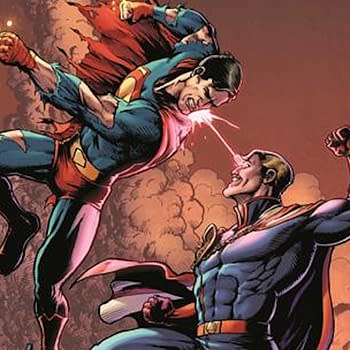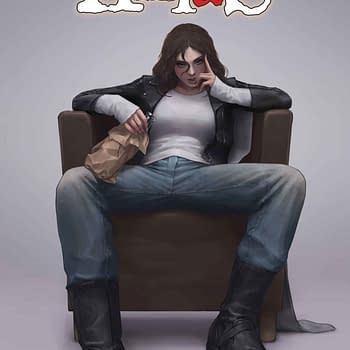Posted in: Comics, Marvel Comics, Spider-Man | Tagged: clone saga, miles morales, spider-man. marvel
Marvel Comics Reveals Miles Morales: Spider-Man Clone Saga Tomorrow
Marvel Comics has thrown up a teaser for Miles Morales: Spider-Man #25 out in April as a comic that "kicks off the Clone Saga". Words that may fill some Spider-Man fans with dread. Telling us "In April 2021, things get wild for Miles. Stay tuned tomorrow for more information" and promising "double trouble, it's worth looking back at what once was, over twenty-five years ago.

Miles Morales has been messing with Clones of late, leading Bleeding Cool to run this article last year. And now it all comes together.

The "Clone Saga" or "Spider-Clone Saga" was a major story arc in Marvel Comics which ran from 1994 to 1996 involving many clones of Spider-Man. Although it was intended to wrap up in less than a year, the comics sold very well and the writers were encouraged to prolong the saga as long as possible. Although many people involved were involved in its creation, the Clone Saga is most closely associated with Terry Kavanagh, who proposed the idea, Howard Mackie, who worked on the majority of the smaller crossovers involved in the overall story arc, and Gerry Conway, who devised the original story. Executive editors on the storyline included Tom DeFalco, Bob Budiansky, and Bob Harras.
The story saw the reappearance of the thought-dead Spider-Man clone from the seventies. He had survived the battle with the Jackal and for five years had lived an existence under the name Ben Reilly, developing a superhero identity of his own as the Scarlet Spider after returning to New York City. A series of chaotic events followed, in which Peter and Ben were plagued by both a resurrected Jackal and by Kaine, who was an unsuccessful first clone of Spider-Man. In the process, another clone of Spider-Man became the villain Spidercide.
Medical tests indicated Peter was actually the clone and Ben the original. Peter temporarily retired as Spider-Man, leaving the mantle of Spider-Man to Ben while he prepared for his new role as a father after the discovery that Mary Jane was pregnant; Peter even lost his powers for a time during his 'retirement', although they eventually came back after a near-death experience. The climax revealed that Peter, Ben, the Jackal, Judas Traveller and many others had all been manipulated for years by Norman Osborn, a.k.a. the Green Goblin, who had returned from the dead and had been secretly masterminding the entire saga. Osborn said Peter was the original—having faked the evidence that revealed Peter's status as the clone as part of a plan to break Peter's spirit—a claim that was confirmed when Ben died saving Peter's life and his body degenerated like any other clone.
Until everything changed again, of course. The event was intended to rival DC Comics' Death of Superman and Batman: Knightfall. Then-Spider-Man editor Mark Bernardo said "Marching orders we were given by upper management to come up with something similar in scope to DC's "Death of Superman" storyline, which at the time was breaking sales records left and right. Thus, no outrageous idea was out of bounds. Terry Kavanagh was cajoled into blurting out his clone idea, which first met with groans and indifference until someone (to my recollection, J.M. DeMatteis) suddenly realized the radical possibilities of such a storyline… The whole arc was supposed to end in Amazing Spider-Man #400, and leave 'Ben Reilly' as the one and only 'original Peter Parker' and forge a new beginning. The whole storyline was supposed to simplify Spider-Man's mythos and ultimately bring him "back to basics." Several of the Spider-Man creators believed that the character had drifted too far from his original portrayal and sought a way to restore the Spider-Man of old, in particular jettisoning his marriage to Mary Jane. Howard Mackie revealed, "When the story was begun we knew it would be controversial, and that was part of the point."
With a plethora of writers and editors, the storyline was initiated throughout all the regular Spider-Man series but slowly grew out of control. The sales department requested extensons to the storyline, buoyed up by very strong sales on the book at a time when most other comics were experiencing a noticeable decline. With this extension, the storyline outlived several key creative staff and many decisions on the eventual direction of the storyline were changed.
With Amazing Spider-Man #400, in a controversial decision, the writers ended the life of Spider-Man's Aunt May Parker, a major supporting character since 1962. The "Mark of Kaine" arc added still more clones of Spider-Man. With this arc, the sales of the Spider-Man comics skyrocketed, and therefore, the writers were encouraged to keep the saga going even longer.
The decision to replace Peter with Ben as the regular, true Spider-Man met with a massive outcry from many readers and was also unpopular with many of the creative staff of the day. Many staff that had a hard time accepting Ben as Peter's replacement, such as the new writer of Sensational Spider-Man, Dan Jurgens. Jurgens wanted to work on the Peter Parker version of the character and was disappointed to have Ben instead, and so he made a plea to Budiansky to bring back Parker, arguing that Ben confused new readers, and was a disappointment to longtime readers who had grown to love Parker. Budiansky was sold on the idea.
The task of actually reestablishing Parker as the true Spider-Man without it seeming like a cop-out was daunting enough that Budiansky invited the whole of Marvel's staff to offer ideas. Greenberg recalled "I think even the janitor and the mailroom guys weighed in at one point. It got a little out of hand, to put it mildly… the memos really started coming in at this point, fast and furious… and I've still got every single one of them, in one big, thick, hernia-inducing file." To provoke new interest from the readers, the storyline "Return of Kaine" introduced a skeleton that was discovered in the original clone saga lab wearing a Spider-Man suit; however, none of the writers or editorial staff had a theory of what the skeleton's significance was.
Finally, Jurgens wrote a memo proposing that the saga would end with Ben being revealed as a clone and dying in a climactic act of heroism, while Mary Jane has a miscarriage and separates from Peter. He concluded the memo with "This proposal has holes. But I believe it serves as a general framework we can all work with to fill in as needed. This is my last shot. After this, I give up." In November 1995, a story outline drafted by Jurgens and Budiansky and titled "Blood Brothers" was distributed to the Spider-Man staff. It roughly followed the idea proposed in Jurgens' memo but added in the revelation that the mastermind behind the saga was Harry Osborn.
Now Editor-In-Chief, Bob Harras rejected the idea of Osborn being the villain and ordered the "Clone Saga"'s finale to be postponed six months to avoid competition with the crossover storyline "Onslaught". Jurgens left Marvel in frustration at the postponement. Published issues had already dropped clues at Harry Osborn being the villain, and with him eliminated, Budiansky felt compelled to write a memo forbidding that Harry's father Norman take the role: "Norman's death should never be undone, in my opinion. It's too classic… Let him rest in peace." However, as part of a fresh wave of downsizing in Marvel's ranks, Budiansky was laid off.
Harras replaced Budiansky with Ralph Macchio as an editor, who declared that Norman Osborn would be the master planner of the cloning. Glenn Greenberg recalled that "The reaction was not enthusiastic. I don't think ANYONE – from the writers to the editors to the assistant editors – agreed with Harras's idea, although his rationale certainly made sense to a certain extent. Harras felt that there was only one person who could have had the money, the resources, the connections, the knowledge, and the motivation to orchestrate the Clone Saga and disrupt Peter Parker's life to such a profound extent." The saga was resolved in "Revelations", which concluded in Spider-Man #75.
In order to give Norman Osborn's return some credibility and link to continuity, Greenberg charted a detailed timeline to explain how
Ex-editor-in-chief Tom DeFalco said that under him, the Clone Saga would have been resolved in a different way: "Our plan was to structure the clone saga like a three-act play. Act One would climax at or around Amazing #400—when we revealed that Pete was the clone and Ben was the real guy. Act Two would last around three months and follow Ben's adventures. In Act Three, Peter would triumphantly return as the one, true Spider-Man. Mark and I was hoping the Spider-crew could make Ben a viable character during his turn in the spotlight, and we planned to star Ben in his own monthly title after Peter returned. It was kind of like what I had already done with Thor and Thunderstrike—two very different titles based on a single concept. Of course, our plan went into the trash the day I got fired."
I am guessing that, if Miles Morales is bringing back a Clone Saga, that it might be a little simpler this time around.












